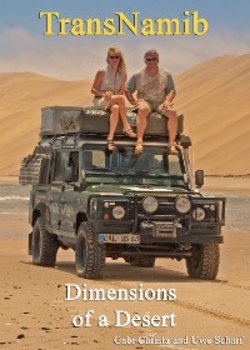Читать книгу TransNamib: Dimensions of a Desert - Gabi Christa - Страница 14
ОглавлениеSnow in the Desert, Aus
Looking for the meaning of this name, I find diverse information. Once, in the Nama language, I find that it means a bitter bush, under other circumstances, Aus has been allocated the exciting meaning of “Place of the Snakes”. Tonight, it is the place of the scorpions. A strong wind hits the campfire and whips the flames high up into the sky, so that the sparks fly in all directions. One creature dashes about the table legs and nervously we see that it is a light-brown, yellowish scorpion. The more we flash our torch, the more scorpions we discover. The Cape Scorpion (Buthidae parabuthus capensis) has got small pincers and a thick tail and is dangerous. The flash of the torch confuses the creatures; agitated, they erect their tails and speed past the table legs, one left, one right. I immediately pull my feet up on to the chair and I am happy to have a rooftop tent available to sleep in and not the animated ground.
During the diamond rush, Aus formed an important link between Keetmanshoop and Lüderitz. When transport was provided by ox and horse wagon, it was the last provisioning post before the very demanding journey through the desert. It came as a great relief, when, after a mere three months of construction, the rail connection between Lüderitz and Aus was established in 1906/07. Today, we see only broken rails lying around. For ten years already, they have been working on the railroad and it is due to be completed in 2015. Until then, goods traffic from Keetmanshoop has to end at Aus and all of the transport through the desert to Lüderitz must travel on the well-developed B4 road. The small settlement of Aus in the Namib Desert lies at 1.485 metres above sea level on the edge of the Huib Plateau. There are few places in Namibia where you can expect snow every two or three years but Aus is one of those. I am longing for some snow; it has been hot already all day and even the night will not bring the coolness I hope for. The pictures in the guesthouse look Utopian. They depict the area around Aus as a winter landscape with snow-covered houses.
At the end of World War I, the former base of the German Schutztruppe troops was converted and after the surrender in 1915 served as a detention camp. More than 1.550 Germans were detained here. In the beginning, the prisoners were accommodated in tents. Suffering from the harsh climate, they were allowed to set up decent clay brick houses. The prisoners went to work in their traditional German way. They had piped water installed and in the small gardens vegetables were grown successfully. The remaining ruins, at a distance from the centre of Aus, are today a national monument. Although in the houses the prisoners were better off than in the tents, many didn’t survive. What a strange irony of war. In the graveyard the former enemies are buried together with the deceased inhabitants of Aus. In 1918, the Spanish Flu came raging even here and killed thousands within a few months. After the signing of the Treaty of Versailles in June, 1919, the last prisoners of war were set free. In the Treaty of Versailles Germany had to renounce all her rights and claims concerning any overseas property to the allied and associated powers. As a consequence, many Germans were dispossessed and deported to Germany. But as a result of good co-operation with the South Africans, those who stayed and those who returned were compensated for. Today, Aus is an insignificant settlement along the B4 leading from Keetmanshoop to Lüderitz. To the right, the road defines the southern end of the Namib-Naukluft-Park.
